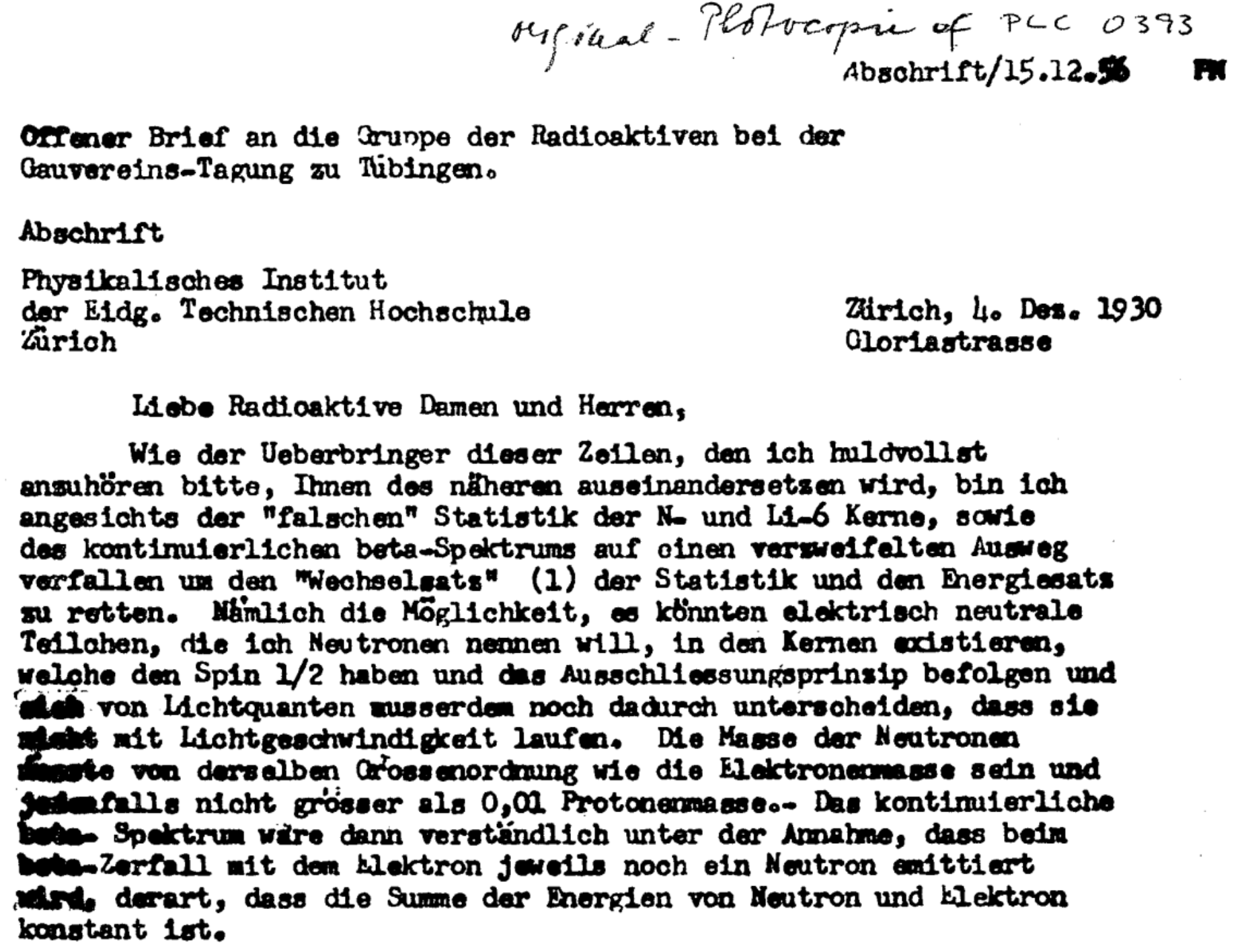Sterile Neutrino Searches
History of the Neutrino
The neutrino (whose name means "little neutral one") was first hypothesized to exist by Pauli in 1930. Nuclear beta decay, at the time, was known to convert a neutron into a proton by emission of an electron, but when the energies of the outgoing electrons were measured, rather than seeing a sharp peak in the energy spectrum (indicating that the electron and proton, between them, conserved momentum), instead physicists observed a smooth energy distribution, allowing the outgoing electron to take a range of different energy values. Pauli conjectured that there must have been a third neutral particle that participated in the nuclear reaction that carried away some of the energy and momentum.
In 1956, the neutrino was detected for the first time by Cowan, Reines, Harrison, Kruse, and McGuire, who took advantage of a similar mechanism to nuclear beta decay. Specifically, this was confirmation of the existence of the electron neutrino, νe, defined because it couples to its electron counterpart. Later, other flavors of neutrinos were observed, as well, called the muon neutrino (νμ) and tau neutrino (ντ).
Neutrino Oscillations
Also around this time, Bruno Pontecorvo proposed an idea that would later (with the help of Maki, Nakagawa, and Sakata) become the now-familiar phenomenon of neutrino oscillation. Strangely, the three flavors of neutrinos mix with one another; a beam of νe traveling through space can spontaneously turn into a mix of not just νe but νμ and ντ, as well. Neutrino oscillations were confirmed with the observation and resolution of the solar neutrino problem, where physicists discovered that the number of neutrinos arriving at Earth from the sun was only a third of what was predicted by theory. The scientists that made this discovery were awarded the 2015 Nobel Prize in Physics.

Sterile Neutrinos
Many experiments studying neutrinos have revealed unexpected results that can't be fully explained by the three known neutrino flavors alone. For instance, in some cases, there is a deficit in the number of detected neutrinos compared to predictions, suggesting that some neutrinos may be transforming into another kind of neutrino during their journey through space. Additionally, the observed oscillation patterns of neutrinos sometimes deviate from what is predicted by the three-flavor model, hinting at the possible existence of one or more additional neutrinos. Strictly speaking, physicists are fairly certain that there are three "active" neutrinos in the Standard Model, but one popular resolution to these conundrums is the existence of a neutrino that does not participate in the weak nuclear force; this is the so-called sterile neutrino.
Sterile neutrinos have been proposed as a candidate for dark matter, the mysterious substance that constitutes a significant portion of the universe's mass. While this connection to dark matter is speculative, it underscores the potential importance of sterile neutrinos in our understanding of fundamental physics and the cosmos. If sterile neutrinos are detected and confirmed, it would revolutionize our understanding of neutrinos and the universe at large, opening new avenues of research and exploration in particle physics and cosmology.
Hunting Sterile Neutrinos with IsoDAR
IsoDAR is designed to create a constant stream of electron antineutrinos by irradiating a Lithium-Beryllium target with accelerated protons. When this accelerator is paired with a kiloton-scale neutrino detector, we can compare the number of neutrinos detected with our detector to the number of neutrinos produced in our target region, and if we observe a deficit, we can conclude that some of these neutrinos oscillated into an additional sterile state. In just five years of running, IsoDAR can set impressive limits on what (if any) kinds of sterile neutrinos can exist given our observed experimental data. This is owed to IsoDAR's ideal experimental setup: creating a flux of electron antineutrinos from a single, well-understood isotope allows IsoDAR to limit systematic errors as much as possible. This allows IsoDAR to test for sterile neutrinos in a model-indepent way; simply meaasuring the disappearance of these electron antineutrinos as a function of length and energy, as shown in the waveforms below.

Source: Phys. Rev. D 105, 052009 (2022).